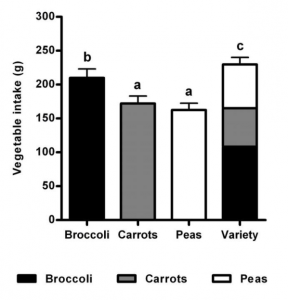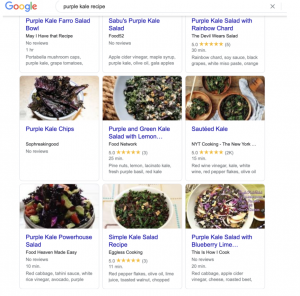As part of a balanced omnivorous diet, the stuff of plants powers our performance. Leafy greens, legumes and fruits provide our biologic systems with the ingredients of movement, protection and longevity. For example, biotin, derived from soybeans and other legumes, drive human energy. Vitamin E, found in spinach and kiwi fruit, combats cellular damage. Or vitamin C (ascorbic acid) from peppers and kale, are our guards of the Nightwatch, safeguarding our biology from the same process that browns a banana.
So what tactics can help you and I eat more vegetables?
Variety
Meegns et al (2012) showed that people eat more vegetables when a variety of veggies are served instead of a single type. This is because we quickly lose interest in one taste. This phenomena of ‘sensory-specific satiety’ explains how we can ingest volumes of food at a buffet.
In the graph below, you can see that veggie variety can spice up a meal!

Addition or Substitution
Veggies can be substituted or added to any meal to increase fullness and reduce hunger and can be used to aid weight loss. You see plants use sun energy to convert water and carbon dioxide to glucose (aka sugar). Then the glucose is organised into long chains of slow digesting carbohydrates. Most of the mass of veggies come from water, fibres and chains of plant glucose.
This makes veggies not energy laden or low in calories. For example, a cup of Broccoli has about 15% of the energy in a cup of rice, said another way, you’d have to eat 6 cups of broccoli to get the same amount of energy as a cup of rice. Which do you think would make you feel fuller?
Secret Celery
Do you find the sight of veggies repulsive? Or is the volume of veggies tiresome to eat? Hiding, pureeing or disguising veggies in a meal is a hack investigated by Blatt et al (2011). Researchers manipulated the vegetable contents of an entree of carrot bread, mac and cheese or chicken rice casserole by adding 15 and 25% more pureed carrots, squash and cauliflower. Participants were also asked to rate the taste, appearance and fullness-effect of each meal.This strategy increased their vegetable intake by two additional serves per day.
At the end of the study, research found that participants not only reported no taste, texture or appearance differences, they also ate less calories per meal.
When chopped veggies are too hard to swallow, puree!
Taste
I haven’t always liked veggies. I found the smell of asparagus akin to old knee sleeves or the texture of mushrooms rubbery. Unsurprisingly, if you don’t like the taste of a veggie you’re unlikely to eat it. Often this is a shadow of childhood exposure to veggies. Thankfully this can be undone. Nicklas et al (2013) showed that adults and children can learn to like veggies by repeated exposure to the veggie when paired with a favourite taste or food.
It wasn’t until a 2010 dinner when my aunt cooked prosciutto wrapped asparagus with garlic butter did I realise that maybe I did like them. Or that mushrooms soaked in a tomatoey bolognese are almost indistinguishable.
Next time you are at a fancy restaurant, explore how they prepare and cook their vegetables and you might be surprised. The once offensive vegetable may become part of your favourite foods.
Veducation
The most powerful way to get more veggies is education. Learning to cook with a wide range of vegetables in a variety of meals means you have more recipes on your mind. You can do this by speaking with friends and colleagues or by searching the net. Here is a search for how to prepare ‘Purple Kale’. Some of the meals take less than 15 minutes!

One-on-one coaching has been reported to be the most effective way to help learn behaviour modification. Pomerlueau et al (2005) showed that a weekly individualised advice helped adults increase their vegetable intake over 6 months.
The importance of education is obvious from the vegetable variety study. 12 months after the study researchers followed up with participants. They found approximately 60% of participants who increased their vegetable intake returned to their baseline intake because, as participants said, they did not know how to prepare the food.
Summary
To hack your vegetable intake, do these 5 things.
- Add one or two new vegetables to your veggie repertoire and have more than one vegetable on your plate.
- Swap some, but not all, of your grains or meats for a mixture of veggies. Remember, you can eat a greater volume of veggies to grains or meat.
- Vegetables take on the taste of other foods when sautéed, pureed or sauced in a meal. A bag of spinach will wilt to less than a cup and is easily hidden in casseroles, bolognese and stir fries.
- Practice pairing your favourite flavours with veggies to learn new tastes and dishes.
- Learn the skill of cooking and ask for cooking advice from a friend, family member or get in touch with Range of Motion Nutrition Coaching.





